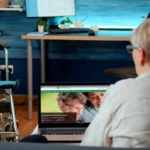Hip Bursitis

by Paula Allia PT, DHSc, MTC, OCS
The hip has multiple bursae around the joint. These bursae are sacs of fluid that are between two surfaces, usually soft tissue structures and bone. Decreasing friction between these surfaces allows for fluid motion without irritating the tendon or muscle in order to participate in various movements like walking, running, tennis or golf. All of these activities use varying degrees of strength and flexibility and all get help from the bursa to perform.
Proper alignment and recruitment of the anatomical structures in a timely manner allow for appropriate movement patterns to occur with the execution of an activity. If proper recruitment does not occur, abnormal rubbing of surfaces can aggravate the bursa and cause inflammation.
Rheumatoid arthritis and an infectious bursa may also cause the bursae to swell. Two common bursal problems of the hip are the trochanteric and iliopsoas bursae. Initially, the pain can feel sharp in a localized area but then chronically if undiagnosed can become achy and more diffuse and can actually refer pain into the leg.
Finding a bursa that is inflamed is a challenge in itself. Once found doctors may prescribe non- steroidal anti-inflammatories and ice. Also important is finding what the cause of this inflammation is and then treating this cause.
Paying attention to the symptoms in the hip are essential for getting the right diagnosis. Once diagnosed, finding the cause and altering the abnormalities can allow the healing of the bursa. If the cause is not figured out, the inflamed bursa may return and become a chronic issue thus making the right changes are pertinent.
The trochanteric bursa sits on the lateral or outside portion of the hip. It can be injured by directly bumping the hip especially if hitting it repeatedly. Sleeping on one side always can also create a vulnerability to this bursal irritation from the constant pressure on it. It also can be irritated by repeated activities that cause the bursa to be rubbed between the muscle and bone.
If this area goes untreated adhesions can occur which actually worsens the problem.
Proper length tension of associated muscles and tendons is an important component of good physiological movement so that tissues can glide without excessive friction over this area. Tight or weak gluteal muscles, hip abductor muscles, and internal and external rotators as well as iliotibial band (ITB) limitations can lead to this diagnosis.
Muscles need to be flexible but not overly extensible. A tight muscle rubbing repeatedly over a bursa can cause irritation. If the muscle or tendon gets irritated as well, tendinopathy can also occur. If too much laxity is present, other muscles or ligaments have to kick in more which can be over working the area.
Too much tightness certainly restricts proper excursion and can cause compressive forces to the hip with increased friction. These movement dysfunctions indeed may lead to irritation of the bursa. The Iliopsoas bursa is on the anterior and just inferior and medial to the hip just under the iliopsoas muscular attachment.
The iliopsoas is comprised of more than one muscle. The iliacus arises from the inside portion of the pelvis while the psoas comes down to the femur (thigh bone) from the spine. These muscles join together and attach down on the proximal femur with the bursa attempting to decrease friction when these muscles are active. If these muscles are tight and rubbing on the bursa, irritation may also occur.
Treating bursitis by applying ice or medications by physicians may start to reduce inflammation. Cold laser may also be used. If gone untreated, pain may ensue enough to warrant an assistive device while weight bearing to decrease the load and lessen the friction on this already irritated structure.
Once under control, appropriate stretching of tight muscles and strengthening of the muscles can begin. Correcting imbalances will help return to anormal functioning hip so that activities can be restarted without discomfort.
What does one do if they suspect bursitis? Seek out the physical therapist that can identify the cause and provide therapy to return to normal.
Here’s To Your Health!
Find that professional that understands the body fully and help to guide you to your longevity in activities. Exercise smart and undo excessive strains. For further information, please call Fitness Together in downtown Naples at (239) 263-9348.




Leave a Reply
Want to join the discussion?Feel free to contribute!